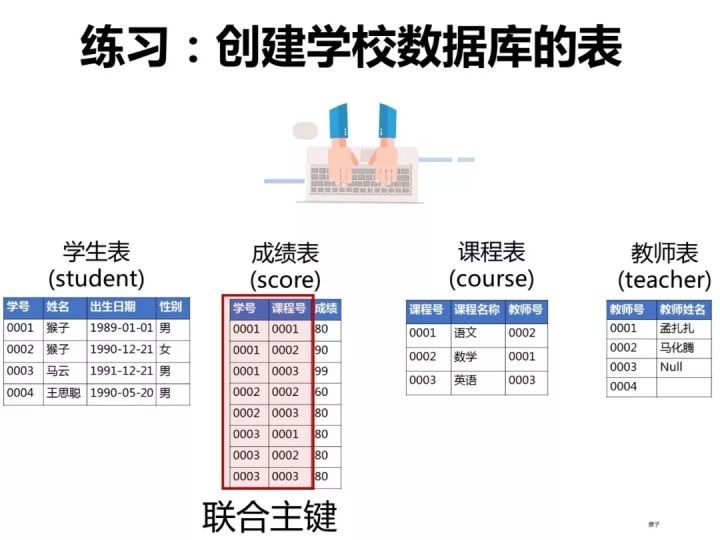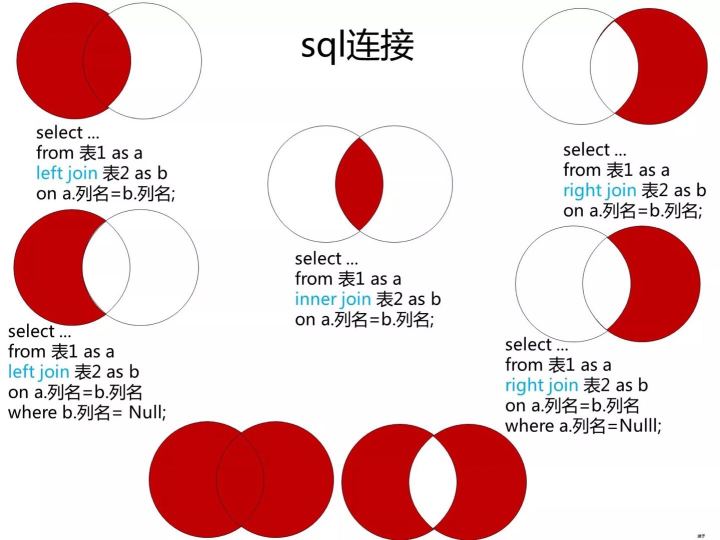本次回顾复习了四种查询类型,并对提高SQL查询效率做了简单的介绍。
题目为之前创建的4个表:学生表、成绩表、课程表、教室表

使用函数 insert into...values...
e.g.
insert into student(学号,姓名,出生日期,性别)
values('0001' , '猴子' , '1989-01-01' , '男');
insert into student(学号,姓名,出生日期,性别)
values('0002' , '猴子' , '1990-12-21' , '女');
insert into student(学号,姓名,出生日期,性别)
values('0003' , '马云' , '1991-12-21' , '男');
insert into student(学号,姓名,出生日期,性别)
values('0004' , '王思聪' , '1990-05-20' , '男');一、简单查询
使用select、from、where、like、%等关键词
(1)查询姓“猴”的学生名单:
select *
from student
where 姓名 like '猴%';(2)查询姓名中最后一个字是“猴”的学生名单:
select *
from student
where 姓名 like '%猴';(3)查询姓名中带“猴”的学生名单:
select *
from student
where 姓名 like '%猴%';(4)查询姓“孟”老师个数:
select count(教师姓名)
from teacher
where 教师姓名 like '孟%';二、汇总分析
使用distinct、sum、group by、having、order by等关键词
(1)查询课程编号为‘0002’的总成绩:
select sum(成绩)
from score
where 课程号='0002';(2)查询选了课程的学生人数:
select count(DISTINCT 学号) as 学生人数
from score;(3)查询各科成绩最高和最低的分:
select 课程号,max(成绩) as 最高分, min(成绩) as 最低分
from score
group by 课程号;(4)查询每门课程被选修的学生数:
select 课程号, count(学号) as 选课人数
from score
group by 课程号;(5)查询男生、女生人数:
select 性别,count(*) as 人数
from student
group by 性别;(6)查询平均成绩大于60分学生的学号和平均成绩:
select 学号, avg(成绩) as 平均成绩
from score
group by 学号
having avg(成绩)>60;(7)查询至少选修两门课程的学生学号:
select 学号, count(课程号) as 选课数
from score
group by 学号
having count(课程号)>=2;(8)查询同名同姓学生名单并统计同名人数:
select 姓名, count(学号) as 同名人数
from student
group by 姓名
having count(学号)>1;(9)查询不及格的课程并按课程号从大到小排列:
select distinct 课程号
from score
where 成绩>60
order by 课程号 desc;(10)查询每门课程的平均成绩,结果按平均成绩升序排序,平均成绩相同时,按课程号降序排列:
select 课程号, avg(成绩) as 平均成绩
from score
group by 课程号
order by 平均成绩 asc, 课程号 desc;(11)检索课程编号为“0004”且分数小于60的学生学号,结果按按分数降序排列:
select 学号
from score
where 课程号='0004' and 成绩<60
order by 成绩 desc;(12)统计每门课程的学生选修人数(超过2人的课程才统计)
要求输出课程号和选修人数,查询结果按人数降序排序,若人数相同,按课程号升序排序
select 课程号, count(学号) as 选修人数
from score
group by 课程号
having count(学号)>2
order by 选修人数 desc, 课程号 asc;(13)查询两门以上不及格课程的同学的学号,以及不及格课程的平均成绩:
select 学号, avg(成绩) as 平均成绩
from score
where 成绩 < 60
group by 学号
having count(成绩)>2;三、复杂查询
子查询问题
(1) 查询所有课程成绩小于60分学生的学号,姓名
select 学号,姓名 from student
where 学号 in(
select 学号 from score group by 课程号 having max(成绩) < 60);(2)查询没有学全所有课的学生的学号,姓名
select 学号,姓名 from student
where 学号 in (
select 学号 from score group by 学号
having count(课程号) < (select count(课程号) from course));(3)查询出只选修了两门课程的全部学生的学号和姓名
select 学号,姓名 from student
where 学号 in (
select 学号 from score group by 学号 having count(课程号) = 2);(5)1990年出生的学生名单
select 学号,姓名 from student
where year(出生日期) = 1990;面试题类型:topN 问题
分组取魅族最大值、最小值、每组最大的N条(topN)记录
关联子查询
(1)分组取每组最大值
e.g.
按课程分组取成绩最大值所在行的数据
select * from score as a
where 成绩 = (
select max(成绩) from score as b where b.课程号 = a.课程号 group by 课程号);(2)分组取每类最小值
e.g.
按课程号分组取成绩最小值所在行的数据
select * from score as a
where 成绩 = (
select min(成绩) from score as b where b.课程号 = a.课程号 group by 课程号);(3)每组最大的N条记录
e.g.
查询各科成绩前两名的记录
(select * from score
where 课程号 = '0001'
order by 成绩 desc limit 2)
union all
(select * from score
where 课程号 = '0002'
order by 成绩 desc limit 2)
union all
(select * from score
where 课程号 = '0003'
order by 成绩 desc limit 2);四、多表查询
inner join、left join、right join、full join等关键词

(1)查询所有学生的学号、姓名、选课数、总成绩
select a.学号,a.姓名,count(b.课程号) as 选课数,sum(b.成绩) as 总成绩
from student as a left join score as b
on a.学号 = b.学号
group by a.学号;(2)查询平均成绩大于85的所有学生的学号、姓名和平均成绩
select a.学号,a.姓名, avg(b.成绩) as 平均成绩
from student as a left join score as b
on a.学号 = b.学号
group by a.学号
having avg(b.成绩)›85;(3)查询学生的选课情况:学号,姓名,课程号,课程名称
select a.学号, a.姓名, c.课程号,c.课程名称
from student a inner join score b on a.学号=b.学号
inner join course c on b.课程号=c.课程号;(4)查询出每门课程的及格人数和不及格人数(case when ... else ... end)
select 课程号,
sum(case when 成绩›=60 then 1
else 0
end) as 及格人数,
sum(case when 成绩 ‹ 60 then 1
else 0
end) as 不及格人数
from score
group by 课程号;(5)使用分段[100-85],[85-70],[70-60],[‹60]来统计各科成绩,分别统计:各分数段人数,课程号和课程名称
select a.课程号,b.课程名称,
sum(case when 成绩 between 85 and 100
then 1 else 0 end) as '[100-85]',
sum(case when 成绩 ›=70 and 成绩‹85
then 1 else 0 end) as '[85-70]',
sum(case when 成绩›=60 and 成绩‹70
then 1 else 0 end) as '[70-60]',
sum(case when 成绩‹60 then 1 else 0 end) as '[‹60]'
from score as a right join course as b
on a.课程号=b.课程号
group by a.课程号,b.课程名称;(6)查询课程编号为0003且课程成绩在80分以上的学生的学号和姓名
select a.学号,a.姓名
from student as a inner join score as b on a.学号=b.学号
where b.课程号='0003' and b.成绩›80;五、提高SQL查询效率
平时需要养成SQL查询语句书写的习惯:
1. select 子句中尽量避免使用*
(代表选择查询全部数据,且select *用于多表联结时成本巨大)
2.where子句比较符号的左边 尽量避免使用函数
(如果where子句的左边出现表达式或函数,会导致数据库引擎进行全表扫描,从而增加运行时间。)
优化方案:为了提高效率,where子句中的函数或表达式尽量放在比较符右侧
e.g.
比如在成绩表中给每个人加5分,'成绩在90分以上'的条件查询
where 成绩 + 5 >90
优化方案:
where 成绩 > 90 -53.尽量避免使用in 和 not in
(in 和 not in会导致数据库进行全表搜索,增加运行时间)
e.g.
比如,查询第8,9个人的学号和成绩
select 学号,成绩
from score
where 学号 in(8,9);
优化方案如下:
select 学号,成绩
from score
where 学号 between 8 and 9;4.尽量避免使用or
(or 会导致数据库引擎的全表搜索,增加运行时间)
e.g.
从成绩表中选出成绩是88分或者89分学生的学号
select 学号
from score
where 成绩 = 88 or 成绩 = 89;
优化方案如下:
select 学号 from score where 成绩 = 88
union
select 学号 from score where 成绩 = 88;5. 使用limit子句限制返回的数据行数
(如果前台只需要是多行的数据,不使用limit限制行数会返回上万行的情况下,应使用limit限制返回行数。)




















 263
263











 被折叠的 条评论
为什么被折叠?
被折叠的 条评论
为什么被折叠?








